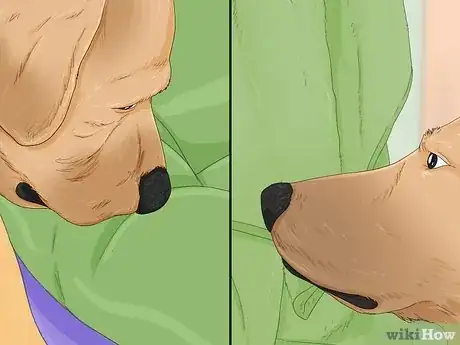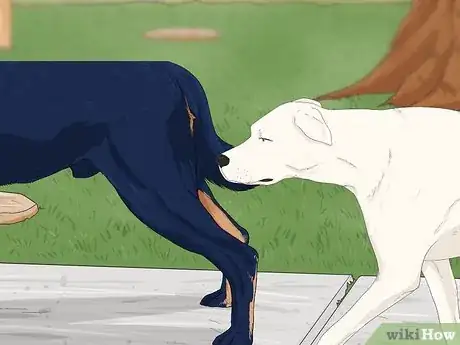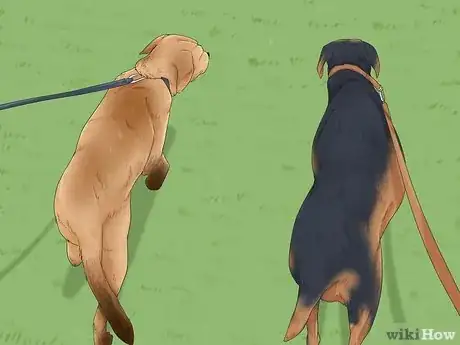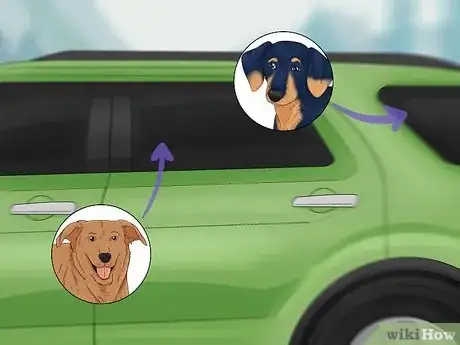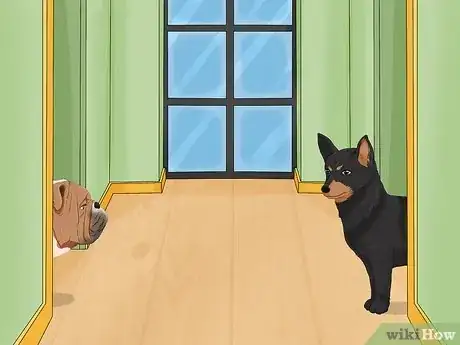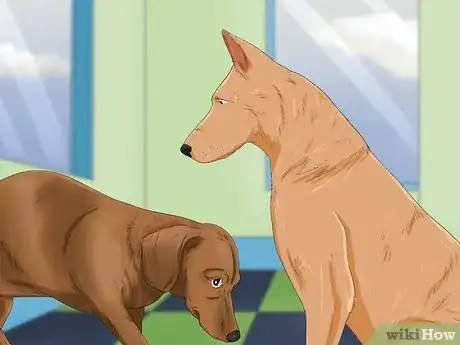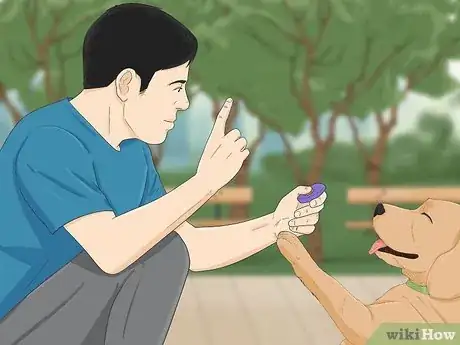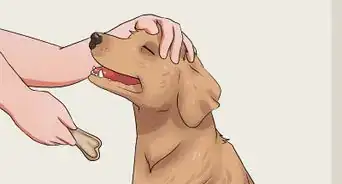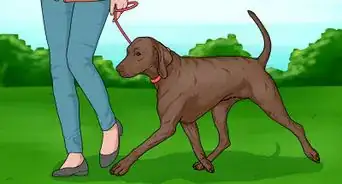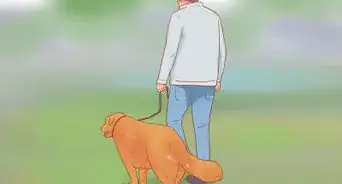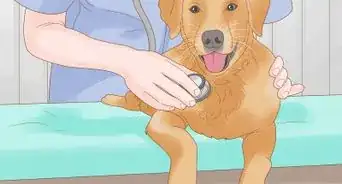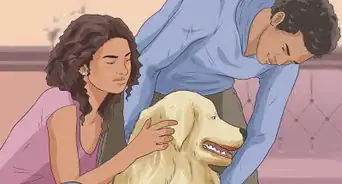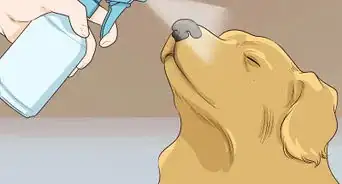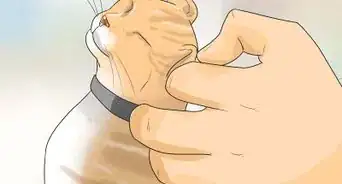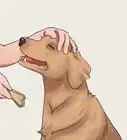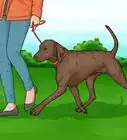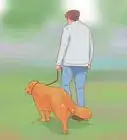This article was co-authored by Rendy Schuchat. Rendy Schuchat is a Certified Professional Dog Trainer and the Owner of the largest dog training facility, Anything Is Pawzible, based in Chicago, Illinois. With over 20 years of experience, Rendy specializes in positive dog training and behavior modification to help people build and strengthen their relationships with their dogs. She holds a BA in Psychology and Communications from the University of Iowa, an MA in Psychology from Roosevelt University, and a Certification in Dog Obedience Instruction from Animal Behavior Training and Associates. Rendy was voted one of the Best/Favorite Dog Trainers in Chicago by Chicagoland Tails Reader’s Choice Awards multiple times and was voted Chicago Magazine’s “Best Dog Whisperer” in 2015.
This article has been viewed 45,794 times.
When you decide to add an additional dog to your household, you must acclimate your dogs to one another properly. This can prevent them from fighting and displaying aggressive behavior toward each other. In most cases, the "old" dog that has already been residing in your home may feel territorial and defend their home against the "new" dog. With the proper introduction between your dogs, however, you can effectively acclimate your dogs and eliminate violence and aggressive behavior in your home.
Steps
Introducing Two Dogs
-
1Perform a scent handshake before the dogs meet. To give two dogs an introduction to each other before they meet in person, you can do what is called a scent handshake. This is when you swap the dogs' blankets to allow them to get used to each other's scents.
- Take the blankets off of the dogs' beds and swap them so that each dog has the other dog's blanket.
- Try to do this at least a day before they meet to give them a chance to investigate the smell and get used to it.
-
2Choose a neutral location for the introduction between your dogs. Choose a location, such as a park or a friend's backyard, that neither of your dogs have visited before. This will help level the playing field, so neither of the dogs feels territorial about where they meet.[1]
- If you introduce your dogs to each other at home, the old dog may display aggressive, territorial behavior toward the new dog.
- If you obtain your new dog from a shelter, the shelter may require you to introduce your dogs to one another at the shelter before you are allowed to take them home.
Advertisement -
3Take your dogs to a neutral location. Ask a friend or family member to meet you at the location separately with one of your dogs. This will allow you to keep the dogs separated until a proper introduction is made.[2]
- Keep leashes on both dogs. This will restrain your dogs and prevent them from attacking one another if aggressive behavior is displayed.
-
4Walk both dogs at a distance from each other. The dogs should be able to see each other but should not be so close that they would feel threatened by the other dog's presence. Then you will gradually move the dogs closer together as you walk.[3]
- If there is no sign of aggression at a distance, you can then move closer to each other.
- Pay attention to both dog's body language. Growling, teeth-baring, raised hair, and long, uninterrupted stares can all indicate aggression. If this occurs you should move the dogs away from each other or immediately redirect the dog's attention.[4]
-
5Allow the dogs to sniff each other. Instruct your partner to start walking their dog, then begin to follow them with your dog. You should be walking close enough so that your dog is walking directly behind the other dog. Continue to walk until your dog begins to sniff the other dog from behind as they are walking.
- Although the dog in front may pause when they sense your dog sniffing, encourage all parties to continue to walk. Trade positions with your partner after your dog has sniffed the other dog. This will allow the dog that was previously in front to sniff your dog from behind.
- Continue to trade positions with your partner until both dogs have experienced the front and back walking positions several times. This will allow your dogs to become more acclimated and familiar with one another.
- Also allow your dogs to sniff one another's excrement and urine after each dog has finished the act. This is a form of communication between dogs and indicates that they are becoming acclimated and comfortable with one another.
-
6Walk the dogs side by side. After the dogs have met each other, you should walk them together for at least 30 minutes. This will allow your dogs to establish direct contact as they continue to maintain a companionable relationship.
- Give your dogs positive praise when you see them acting friendly with one another. Petting your dogs and using verbal praise will encourage them to continue to get along with each other.
- Take a break every few minutes to let the dogs have direct interaction but then continue on the walk. Keep close supervision during direct contact so that you can redirect your dogs if problems arise.
-
7Take your dogs home. After the walk, your dogs will hopefully be relaxed and familiar enough with one another to co-exist in the same living environment without displaying aggressive behavior. At this point, you can take your old dog and your new dog home and begin introducing your new dog to its new home.
- If you need to transport the dogs in a car at this point, you will want to keep them separated. They have met each other but are by no means ready to be put in the back of a car together, for example.
Getting the New Dog Acclimated at Home
-
1Introduce the new dog to its new home gradually.[5] Walk the dog around its new neighborhood before bringing it into its new home. Also, bring it to the area where you want it to go to the bathroom and allow it to do its business.
- Bring the dog into the house and immediately into the room where it will get food and water. Feed the dog and give it water, which will calm it down and get it ready for the grand tour.
- Then walk the dog through every room in the house slowly. Keep the dog on its leash while you walk it through the house.
-
2Keep the dogs separated at first. This will allow you to monitor interactions between dogs closely. Let the dogs sniff at each other through a baby gate. This will allow them each to get used to the scent of the other dog without the risk of aggression.[6]
- If you need to be out of the room, place the dogs in separate rooms so that no conflict arises without you being able to defuse it.
-
3Allow the dogs to establish their own hierarchy.[7] Dogs will naturally establish a hierarchy that allows them to function as a pack. You need to let them work out this relationship on their own, as long as they are not hurting each other in the process.
- There will naturally be a more dominant dog and a more submissive dog in the new relationship. This does not mean that one dog should beat up on the other dog continually. You will need to use your best judgement about whether the relationship is on the right path toward pack behavior or if it is rooted in aggression.
-
4Contact a trainer or animal behaviorist if you cannot get the dogs acclimated to each other.[8] If you cannot get your dogs to get used to each other, you may need to bring in a professional. They should be able to give you good strategies that you can use to acclimate your dogs to each other.
- To find a trainer or animal behaviorist in your area, ask your veterinarian or the organization you got your new dog from for a recommendation.
Expert Q&A
Did you know you can get expert answers for this article?
Unlock expert answers by supporting wikiHow
-
QuestionHow can I be sure my dog will get along with a new dog?
 Rendy SchuchatRendy Schuchat is a Certified Professional Dog Trainer and the Owner of the largest dog training facility, Anything Is Pawzible, based in Chicago, Illinois. With over 20 years of experience, Rendy specializes in positive dog training and behavior modification to help people build and strengthen their relationships with their dogs. She holds a BA in Psychology and Communications from the University of Iowa, an MA in Psychology from Roosevelt University, and a Certification in Dog Obedience Instruction from Animal Behavior Training and Associates. Rendy was voted one of the Best/Favorite Dog Trainers in Chicago by Chicagoland Tails Reader’s Choice Awards multiple times and was voted Chicago Magazine’s “Best Dog Whisperer” in 2015.
Rendy SchuchatRendy Schuchat is a Certified Professional Dog Trainer and the Owner of the largest dog training facility, Anything Is Pawzible, based in Chicago, Illinois. With over 20 years of experience, Rendy specializes in positive dog training and behavior modification to help people build and strengthen their relationships with their dogs. She holds a BA in Psychology and Communications from the University of Iowa, an MA in Psychology from Roosevelt University, and a Certification in Dog Obedience Instruction from Animal Behavior Training and Associates. Rendy was voted one of the Best/Favorite Dog Trainers in Chicago by Chicagoland Tails Reader’s Choice Awards multiple times and was voted Chicago Magazine’s “Best Dog Whisperer” in 2015.
Certified Professional Dog Trainer
-
QuestionHow should I introduce my dog to a new dog?
 Rendy SchuchatRendy Schuchat is a Certified Professional Dog Trainer and the Owner of the largest dog training facility, Anything Is Pawzible, based in Chicago, Illinois. With over 20 years of experience, Rendy specializes in positive dog training and behavior modification to help people build and strengthen their relationships with their dogs. She holds a BA in Psychology and Communications from the University of Iowa, an MA in Psychology from Roosevelt University, and a Certification in Dog Obedience Instruction from Animal Behavior Training and Associates. Rendy was voted one of the Best/Favorite Dog Trainers in Chicago by Chicagoland Tails Reader’s Choice Awards multiple times and was voted Chicago Magazine’s “Best Dog Whisperer” in 2015.
Rendy SchuchatRendy Schuchat is a Certified Professional Dog Trainer and the Owner of the largest dog training facility, Anything Is Pawzible, based in Chicago, Illinois. With over 20 years of experience, Rendy specializes in positive dog training and behavior modification to help people build and strengthen their relationships with their dogs. She holds a BA in Psychology and Communications from the University of Iowa, an MA in Psychology from Roosevelt University, and a Certification in Dog Obedience Instruction from Animal Behavior Training and Associates. Rendy was voted one of the Best/Favorite Dog Trainers in Chicago by Chicagoland Tails Reader’s Choice Awards multiple times and was voted Chicago Magazine’s “Best Dog Whisperer” in 2015.
Certified Professional Dog Trainer
-
QuestionMy new puppy I got last week and my adult dog are getting along with no aggression. But, the adult dog seems sad or annoyed. What should I do?
 Arya TrivediCommunity AnswerYour older dog may be upset about the attention you are giving the younger pup and is just jealous that it is not the star anymore. Try giving them equal amounts of love, and make them play with each other. They will get used to each other in time.
Arya TrivediCommunity AnswerYour older dog may be upset about the attention you are giving the younger pup and is just jealous that it is not the star anymore. Try giving them equal amounts of love, and make them play with each other. They will get used to each other in time.
Warnings
- If you are bringing a new puppy into your home, do not leave the puppy in the company of your adult dog unsupervised. Your puppy may unintentionally pester the adult dog and elicit bites.[9] Keep your puppy separated from your adult dog when unsupervised until the puppy is at least 4 months old.⧼thumbs_response⧽
References
- ↑ Rendy Schuchat. Certified Professional Dog Trainer. Expert Interview. 26 January 2021.
- ↑ http://www.humanesociety.org/animals/dogs/tips/introducing_new_dog.html
- ↑ Rendy Schuchat. Certified Professional Dog Trainer. Expert Interview. 26 January 2021.
- ↑ http://www.humanesociety.org/animals/dogs/tips/introducing_new_dog.html
- ↑ https://www.cesarsway.com/get-involved/bringing-new-dog-home/bringing-your-new-dog-home
- ↑ https://www.cesarsway.com/get-involved/bringing-new-dog-home/bringing-your-new-dog-home
- ↑ https://www.cesarsway.com/dog-training/socialization/a-new-member-of-the-pack
- ↑ http://www.humanesociety.org/animals/dogs/tips/introducing_new_dog.html
- ↑ https://www.cesarsway.com/dog-training/puppy-training/introducing-puppy-to-older-dogs
About This Article
To acclimate 2 dogs to one another, allow them to get used to each other's scent by swapping their blankets for at least 1 day before meeting. Next, choose a neutral location for the introduction, like a park or a friend’s yard, to prevent them from being territorial. Then, allow them to sniff each other and walk them next to each other so they can get used to one another. Once you're home, keep the dogs separated by a baby gate until they're interacting in a friendly manner, with no signs of aggression. For more tips from our Veterinary co-author, including how to let the dogs establish their own hierarchy, keep reading!
